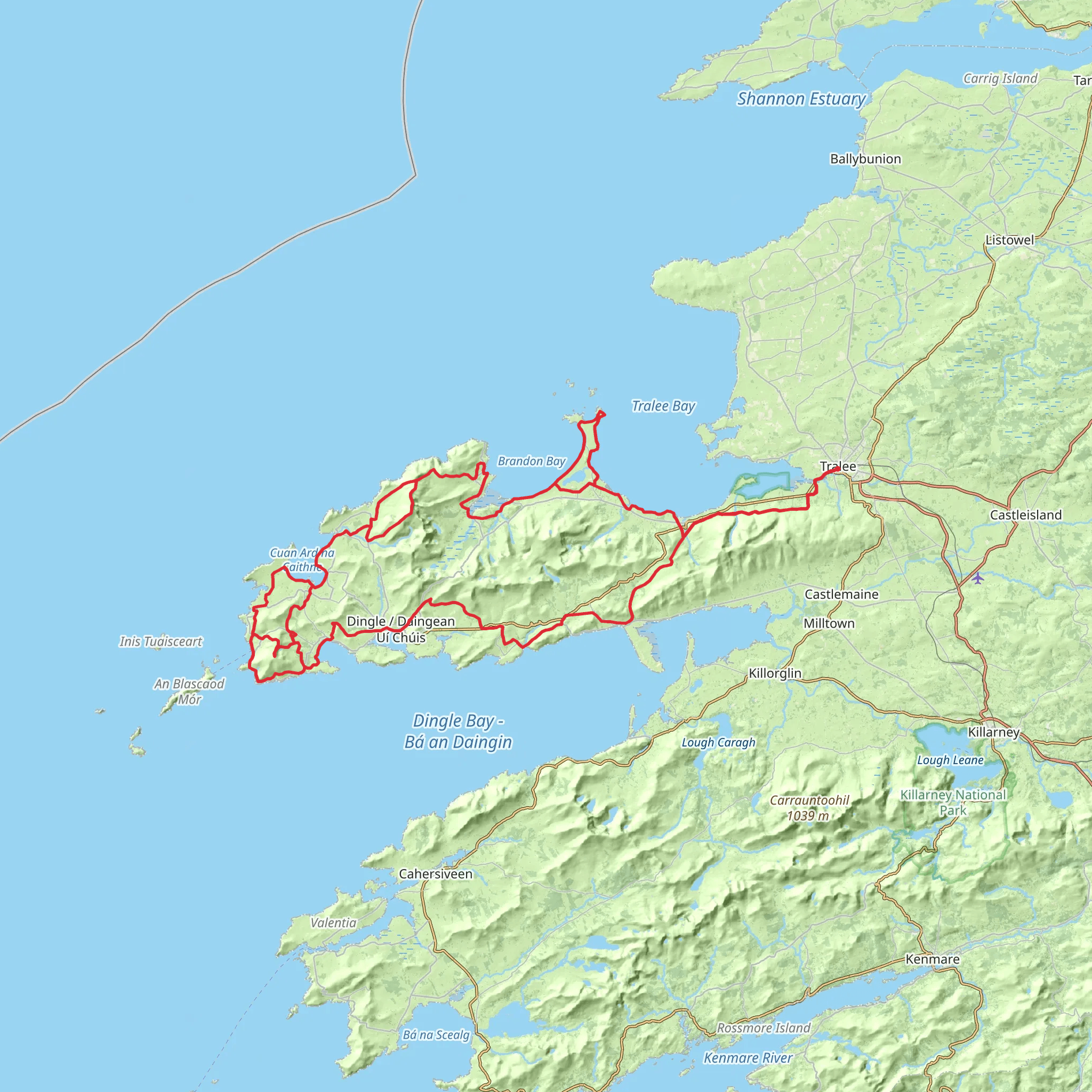Download
Preview
Add to list
More
183.1 km
~8 days
3483 m
Multi-Day
“Embark on the Dingle Way for 183 kilometers of stunning landscapes, rich history, and diverse wildlife.”
Starting near County Kerry, Ireland, the Dingle Way is a captivating loop trail that spans approximately 183 kilometers (114 miles) with an elevation gain of around 3400 meters (11,155 feet). This trail offers a medium difficulty rating, making it accessible for moderately experienced hikers.
Getting There To reach the trailhead, you can travel to Tralee, a town well-connected by public transport. From Dublin, you can take a train or bus to Tralee, which takes about 4-5 hours. If you prefer driving, Tralee is accessible via the N21 from Limerick or the N22 from Cork. Parking is available in Tralee for those arriving by car.
Trail Overview The Dingle Way takes you through a variety of landscapes, from coastal paths and sandy beaches to mountainous terrain and lush green valleys. The trail is well-marked, but it's advisable to use HiiKER for navigation to ensure you stay on track.
Key Sections and Landmarks
#### Tralee to Camp (18 km / 11 miles) Starting in Tralee, the trail heads west towards the village of Camp. This section is relatively flat, with an elevation gain of about 200 meters (656 feet). You'll pass through farmland and small villages, offering a glimpse into rural Irish life.
#### Camp to Annascaul (17 km / 10.5 miles) From Camp, the trail ascends towards the Slieve Mish Mountains, reaching an elevation of around 400 meters (1,312 feet). The descent into Annascaul offers stunning views of the Dingle Peninsula. Annascaul is known for its connection to Antarctic explorer Tom Crean, and you can visit the South Pole Inn, a pub he once owned.
#### Annascaul to Dingle (22 km / 13.7 miles) This section takes you through more varied terrain, including the beautiful Inch Beach. The trail then climbs to around 200 meters (656 feet) before descending into the vibrant town of Dingle. Dingle is famous for its lively music scene and the friendly dolphin, Fungie, who has been a local attraction for years.
#### Dingle to Dunquin (20 km / 12.4 miles) Leaving Dingle, the trail follows the coast, offering breathtaking views of the Atlantic Ocean. You'll pass by the ancient Dunbeg Fort and the Blasket Islands Visitor Centre. The elevation gain here is moderate, around 300 meters (984 feet).
#### Dunquin to Ballydavid (23 km / 14.3 miles) This section is one of the most scenic, with rugged cliffs and panoramic ocean views. The trail climbs to around 250 meters (820 feet) before descending into the quaint village of Ballydavid. Keep an eye out for seabirds and marine wildlife along this coastal stretch.
#### Ballydavid to Cloghane (29 km / 18 miles) The trail heads inland, ascending towards Mount Brandon, the highest point on the Dingle Way at 952 meters (3,123 feet). This challenging climb is rewarded with spectacular views. The descent into Cloghane is steep, so take care.
#### Cloghane to Castlegregory (21 km / 13 miles) From Cloghane, the trail follows the coastline again, passing through the Maharees Peninsula. This section is relatively flat, with an elevation gain of about 150 meters (492 feet). The sandy beaches and dunes are a highlight here.
#### Castlegregory to Tralee (33 km / 20.5 miles) The final stretch takes you back to Tralee, passing through farmland and small villages. The elevation gain is minimal, around 100 meters (328 feet), making for a gentle end to your journey.
Historical Significance The Dingle Peninsula is rich in history, with numerous archaeological sites, including ancient ring forts, standing stones, and early Christian churches. The region has been inhabited for thousands of years, and the trail offers a unique opportunity to explore this historical tapestry.
Nature and Wildlife The Dingle Way is a haven for nature lovers. The coastal sections are home to a variety of seabirds, including puffins and gannets. You might also spot seals and dolphins along the shoreline. The inland sections offer lush greenery and the chance to see native Irish wildlife such as red deer and foxes.
Preparation Tips Given the varied terrain and weather conditions, it's essential to pack appropriately. Waterproof clothing, sturdy hiking boots, and a reliable navigation tool like HiiKER are must-haves. The trail passes through several villages, so you can replenish supplies and find accommodation along the way. However, carrying some snacks and water is advisable, especially for the more remote sections.
Embarking on the Dingle Way promises an unforgettable adventure through one of Ireland's most picturesque regions.
What to expect?
Activity types
Comments and Reviews
User comments, reviews and discussions about the Dingle Way, Ireland.
4.79
average rating out of 5
48 rating(s)

